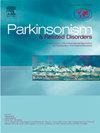路易体病患者DTI-ALPS指数的变化及其与神经元损伤的关系
IF 3.4
3区 医学
Q2 CLINICAL NEUROLOGY
引用次数: 0
摘要
淋巴系统的功能障碍被认为会导致包括β-淀粉样蛋白和α-突触核蛋白在内的有毒蛋白的积累,因此可能与路易体痴呆(DLB)和阿尔茨海默病(AD)有关。沿血管周围空间弥散张量图像分析(DTI-ALPS)指数已被提出作为淋巴功能的标志。目的探讨DTI-ALPS在轻度认知障碍(MCI)和痴呆中的作用,并探讨其与认知能力下降和神经退行性变生物标志物的关系。方法计算DLB [N = 32]、AD [N = 14]、MCI合并路易体(MCI- lb) [N = 31]、MCI-AD [N = 31]和健康对照者(HC) [N = 48]的sdti - alps。血浆生物标志物可用于淀粉样蛋白-β、胶质纤维酸性蛋白(GFAP)、神经丝光(NfL)和磷酸化tau。用18F florbetapir对一部分参与者进行淀粉样蛋白PET成像。结果DTI-ALPS值在DLB(估计值= - 0.084 [-0.14 ~ - 0.03],p = 0.004)和MCI-LB(估计值= - 0.058 [-0.11 ~ - 0.002],p = 0.047)与认知评分基线(t[147] = 2.22, p = 0.028)和纵向下降(t[127] = 2.41,p = 0.017)均显著低于HC。DTI-ALPS与血浆NfL (t[141] = -2.72, p = 0.007)和GFAP (t[141] = -2.83, p = 0.005)有显著相关性,但与淀粉样蛋白水平和淀粉样蛋白PET摄取无关。结论与健康对照者相比,DLB患者的sdti - alps明显降低。我们的研究结果表明,淋巴系统功能障碍可能导致路易体病的神经元损伤。然而,需要进一步的研究来阐明淋巴系统的作用,以及DTI-ALPS作为淋巴功能标记物的特异性。本文章由计算机程序翻译,如有差异,请以英文原文为准。
Changes in DTI-ALPS index and its associations with neuronal damage in Lewy body disease
Introduction
Dysfunction of the glymphatic system is thought to lead to build up of toxic proteins including β-amyloid and α-synuclein, and thus may be involved in dementia with Lewy bodies (DLB) and Alzheimer's disease (AD). The Diffusion Tensor Image Analysis Along the Perivascular Space (DTI-ALPS) index has been proposed as a marker of glymphatic function.
Aims
To investigate DTI-ALPS in mild cognitive impairment (MCI) and dementia, and determine its relationship with cognitive decline, and biomarkers of neurodegeneration.
Methods
DTI-ALPS was calculated on participants with DLB [N = 32], AD [N = 14], MCI with Lewy bodies (MCI-LB) [N = 31], MCI-AD [N = 31] and healthy comparators (HC) [N = 48]. Plasma biomarkers were available for amyloid-β, glial fibrillary acidic protein (GFAP), neurofilament light (NfL), and phosphorylated tau. Amyloid PET imaging with 18F florbetapir was performed on a subset of participants.
Results
DTI-ALPS values were significantly lower compared to HC in both DLB (Estimate = −0.084 [-0.14 to −0.03], p = 0.004) and MCI-LB (Estimate = −0.058 [-0.11 to −0.002], p = 0.047) DTI-ALPS was also significantly associated with both baseline (t[147] = 2.22, p = 0.028) and longitudinal decline (t[127] = 2.41,p = 0.017) in cognitive score. There were significant associations of DTI-ALPS with plasma NfL (t[141] = -2.72, p = 0.007), and GFAP (t[141] = -2.83, p = 0.005), but not amyloid levels, nor with amyloid PET uptake.
Conclusions
DTI-ALPS is reduced in DLB compared to healthy comparators. Our findings suggest that dysfunction of the glymphatic system may contribute to neuronal damage in Lewy body disease. However further research is needed to clarify the role of the glymphatic system, and also the specificity of DTI-ALPS as a marker of glymphatic function.
求助全文
通过发布文献求助,成功后即可免费获取论文全文。
去求助
来源期刊

Parkinsonism & related disorders
医学-临床神经学
CiteScore
6.20
自引率
4.90%
发文量
292
审稿时长
39 days
期刊介绍:
Parkinsonism & Related Disorders publishes the results of basic and clinical research contributing to the understanding, diagnosis and treatment of all neurodegenerative syndromes in which Parkinsonism, Essential Tremor or related movement disorders may be a feature. Regular features will include: Review Articles, Point of View articles, Full-length Articles, Short Communications, Case Reports and Letter to the Editor.
 求助内容:
求助内容: 应助结果提醒方式:
应助结果提醒方式:


